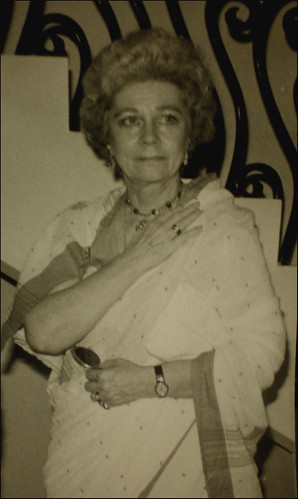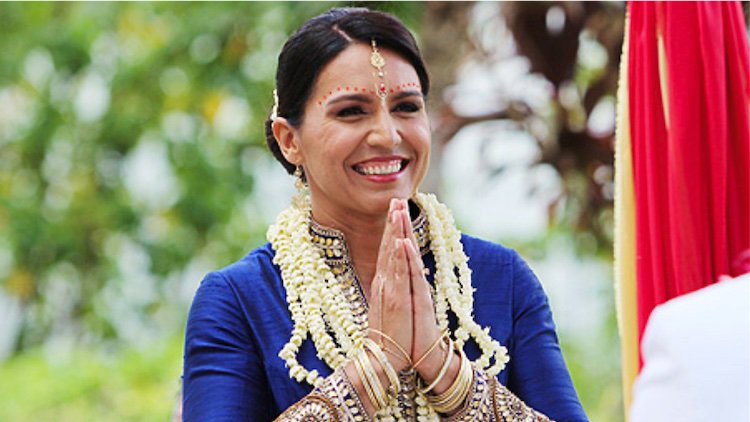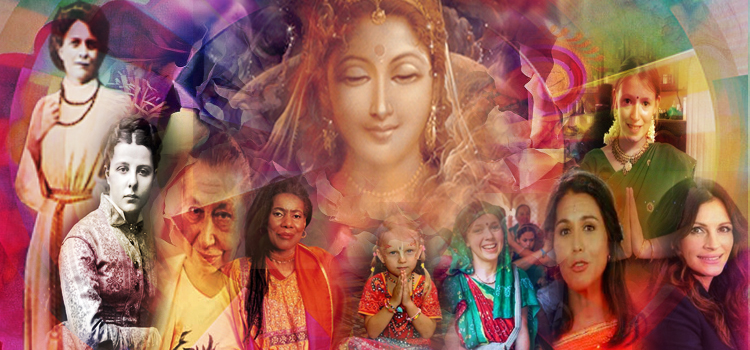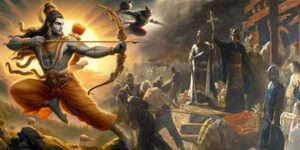 Since time immemorial there have been strong and influential Western women who have been drawn to and been inspired by Hinduism, and who have taken up the mantle of Hindu Dharma, becoming great leaders, swaminis, and gurus as keepers and vanguards of this ancient culture. Today one can witness thousands of Western women turning vegetarian, and practicing meditation, and it is now also a common sight to see them carrying yoga mats on public transport or while walking on the street.
Since time immemorial there have been strong and influential Western women who have been drawn to and been inspired by Hinduism, and who have taken up the mantle of Hindu Dharma, becoming great leaders, swaminis, and gurus as keepers and vanguards of this ancient culture. Today one can witness thousands of Western women turning vegetarian, and practicing meditation, and it is now also a common sight to see them carrying yoga mats on public transport or while walking on the street.
Even though many practitioners follow it purely for fitness, many still adorn their homes with Hindu shrines, altars and deities, while expounding on the deep philosophies of dharma, karma and reincarnation; Hinduism thus becoming an integral part of their daily lives, with Dharma becoming a powerful force in the West.
 Even though the most ancient of the world’s religions, Hinduism has always had an evolutionary matrix which offers an integral mode of living and being- from mere diet and traditions to practical philosophies of yogic attainment and integral knowledge, to creativity and values of freedom, free-thinking and universality, which constantly inspire growth and development of consciousness.
Even though the most ancient of the world’s religions, Hinduism has always had an evolutionary matrix which offers an integral mode of living and being- from mere diet and traditions to practical philosophies of yogic attainment and integral knowledge, to creativity and values of freedom, free-thinking and universality, which constantly inspire growth and development of consciousness.
Another popular aspect of Hinduism that has attracted the Western woman has been the long prevailing respect and practices that adhere to the Goddess, which guides self-realization and development by invoking and incorporating the natural forces of Shakti.
Some of the great women in the past (who deserve mention) who took up Hinduism and became great leaders, charting out the way for others, were from the Western world itself.
 Mirra Alfassa, born a Jew, came to be known as the “Mother” and became a great Hindu spiritual leader and sage in India, who expounded on Aurobindo’s teachings of the Veda and the Gita.
Mirra Alfassa, born a Jew, came to be known as the “Mother” and became a great Hindu spiritual leader and sage in India, who expounded on Aurobindo’s teachings of the Veda and the Gita.
In his article on “How a Proselytized Secular Jew Became a Hindu Spiritual Leader”, Shelomo Alfassa (a distant relative), said that ‘Mirra had once said that in 1904, at age 26, she met during a dream, a dark Asiatic figure whom she called Krishna.
She said that Krishna guided her in her inner journey. She came to have total implicit faith in Krishna, and was hoping to meet him one day in real life. She returned to France where she expanded her study on various Hindu practices and soon would give over her life to the study. She is quoted as saying about Judaism, that God is basically “depicted as the Judge of mankind, and not its Lover as in Hinduism.”
Apart from the creation of Auroville in Pondicherry, which propagates the teachings of the ancient dharma-culture of Hinduism, Mirra also went on to establish the Sri Aurobindo International University.
 Another great scholar who was greatly influenced by Hinduism was Annie Wood Besant.She was known as a woman’s rights activist and was a prominent leader of India’s freedom movement, apart from being the President of the Theosophical Society; she was regarded by George Bernard Shaw- as the “greatest woman public speaker of her time”.
Another great scholar who was greatly influenced by Hinduism was Annie Wood Besant.She was known as a woman’s rights activist and was a prominent leader of India’s freedom movement, apart from being the President of the Theosophical Society; she was regarded by George Bernard Shaw- as the “greatest woman public speaker of her time”.
She strongly believed that India was a victim of the mischief wrought by Christian missionaries and she attempted to lead Indians back to their own gods and arouse their sense of self-respect and pride in the greatness of their religions.
Regarding Hinduism she said:
“After a study of some forty years and more of the great religions of the world, I find none so perfect, none so scientific, none so philosophic, and none so spiritual as the great religion known by the name of Hinduism. The more you know it, the more you will love it; the more you try to understand it, the more deeply you will value it. Make no mistake; without Hinduism, India has no future.
Hinduism is the soil into which India’s roots are struck, and torn of that she will inevitably wither, as a tree torn out from its place. Many are the religions and many are the races flourishing in India, but none of them stretches back into the far dawn of her past, nor are they necessary for her endurance as a nation. Everyone might pass away as they came and India would still remain. But let Hinduism vanish and what is she? A geographical expression of the past, a dim memory of a perished glory, her literature, her art, her monuments, all have Hinduism written across them. And if Hindus do not maintain Hinduism, who shall save it? If India’s own children do not cling to her faith, who shall guard it? India alone can save India, and India and Hinduism are one.”
 Sister Nivedita, born Margaret Noble, an Irish school teacher, moved to India in 1898, after having met Swami Vivekananda following his iconic speech on Hinduism at the 1893 Parliament of the World’s Religions at Chicago. Horrified later by the conditions that had besmirched India after the alien rule, she took up the cause of Woman’s Education in order to awaken the Hindu Nation. She probed into the heart of Indian womanhood and reflected in her eloquent prose the natural simplicity and spiritual fervor of the women of India. Women, she contended, are the embodiment and repository of the ancient wisdom of the East. Regarding Hinduism, she said:
Sister Nivedita, born Margaret Noble, an Irish school teacher, moved to India in 1898, after having met Swami Vivekananda following his iconic speech on Hinduism at the 1893 Parliament of the World’s Religions at Chicago. Horrified later by the conditions that had besmirched India after the alien rule, she took up the cause of Woman’s Education in order to awaken the Hindu Nation. She probed into the heart of Indian womanhood and reflected in her eloquent prose the natural simplicity and spiritual fervor of the women of India. Women, she contended, are the embodiment and repository of the ancient wisdom of the East. Regarding Hinduism, she said:
“Hinduism would not be eternal were it not constantly growing and spreading, and taking in new areas of experience. Precisely because it has this power of self addition and re-adaptation, in greater degree than any other religion that the world has even seen, we believe it to be the one immortal faith.”
Nivedita’s school influenced patriots, revolutionaries, scientists, artists and journalists, engaging them deeply in India’s freedom struggle. She wrote on “Aggressive Hinduism,” and spoke of the aggression and victory of character and ‘spiritual power’ over human frailties and mundane interests, making the world a better place to live in. “This is the doctrine of the ‘Gita’ repeated again and again… Not the withdrawn, but the transfigured life, radiant, with power and energy, triumphant in its selflessness, is religion. ‘Arise!’ thunders the voice of Sri Krishna, ‘and be thou an apparent cause!’, she said. Her Cradle Tales of Hinduism is a gentle rendering of Hinduism’s classic stories, and in her visions, it is said, she saw Mother India guiding the destiny of a world.
In the final moments of her death on October 13, at about 7:00 am, Nivedita, it was said, chanted the Upanishads, “Lead us from the unreal to the Real. Lead us from darkness to Light. Lead us from death to Immortality,” and breathed her last.
 Queen Fredricka of Greece, who was the wife of King Paul, had also come to visit India during her reign, and was largely influenced by the teachings of the Vedanta, which became her philosophy of life and science. It was infact her advanced research in Physics which brought her to the doorstep of Hinduism. Science, said Frederika, has yet to catch up with what the seers in India had already understood over 2500 years ago. She is also quoted to have said to the Rajmata at that time,
Queen Fredricka of Greece, who was the wife of King Paul, had also come to visit India during her reign, and was largely influenced by the teachings of the Vedanta, which became her philosophy of life and science. It was infact her advanced research in Physics which brought her to the doorstep of Hinduism. Science, said Frederika, has yet to catch up with what the seers in India had already understood over 2500 years ago. She is also quoted to have said to the Rajmata at that time,
“You are fortunate to inherit such knowledge. I envy you. While Greece is the country of my birth, India is the country of my soul.”
In more recent times, 31-year old Iraq war veteran,
Tulsi Gabbard, became the first Hindu American Congresswoman who took her ceremonial oath in Congress on the Bhagavad Gita. Proud of her Hindu religion, Gabbard is not Indian.
 She was born in American Samoa to a Catholic father and a Hindu mother. She moved to Hawaii and embraced Hinduism as a teenager and is well-versed in the scriptures. She also practices Bhakti-Yog and Karm-Yog.
She was born in American Samoa to a Catholic father and a Hindu mother. She moved to Hawaii and embraced Hinduism as a teenager and is well-versed in the scriptures. She also practices Bhakti-Yog and Karm-Yog.
“I chose to take the oath of office with my personal copy of the Bhagavad-Gita because its teachings have inspired me to strive to be a servant-leader, dedicating my life in the service of others and to my country,” said Gabbard, who served in the Iraq War, after the swearing-in. “My Gita has been a tremendous source of inner peace and strength through many tough challenges in life, including being in the midst of death and turmoil while serving our country in the Middle East.”
Today Gabbard has become not just a strong political voice but an inspirational icon and role-model for Indian American youths.
 Another great personality and Academy Award-winning actress, Julia Roberts, who is known to have converted to Hinduism, confessed that she has become interested in the spirituality of the Hindu faith because it is more than a “mere religion.” She told The Times of India, that: “Ever since I developed my liking and fondness for Hinduism, I have been attracted and deeply fascinated by many facets of the multi dimensional Hinduism… spirituality in it transcends many barriers of mere religion… opting for Hinduism is not a religious gimmick.
Another great personality and Academy Award-winning actress, Julia Roberts, who is known to have converted to Hinduism, confessed that she has become interested in the spirituality of the Hindu faith because it is more than a “mere religion.” She told The Times of India, that: “Ever since I developed my liking and fondness for Hinduism, I have been attracted and deeply fascinated by many facets of the multi dimensional Hinduism… spirituality in it transcends many barriers of mere religion… opting for Hinduism is not a religious gimmick.
It is similar to Patsy of Razor’s Edge by Somerset Maugham. We share a common aspect of finding peace and tranquility of mind in Hinduism, one of the oldest and respected religions of civilization”. The entire family, she reveals, goes to temple together to “chant and pray and celebrate. “I’m definitely a practicing Hindu,” she says and thinks the whole world should celebrate Diwali because it celebrates “humanity, peace and prosperity.” She said: “Diwali should be celebrated unanimously throughout the world as a gesture of goodwill.
It not only belongs to Hinduism but is universal in nature and in its essence too. Diwali ignites the values of self-confidence, love for humanity, peace, prosperity and above all eternity which goes beyond all mortal factors.”
Twenty-two-year-old German actress-supermodel-singer, Claudia Ciesla, is another fan who is reported to have said, “I love Hinduism`s tolerance and peaceful thinking. I have visited many temples and prayed, which is helping me by way of hope and new energy.” She carries an idol of Hindu Lord Ganesha presented by her Vedic astrologer, which she claimed brought her good luck. She has been quoted as saying: “I think I am very close in my way of thinking and my living philosophy to be a Hindu… and I am sure I would like to be a Hindu when I have all the knowledge about it.”
So what is this undying allure of Hinduism that continues to attract women from all over the world to embrace it? What is it about this ancient dharma-culture that continues to inspire thousands of extraordinary women even today across the western spectrum to become great leaders and role models?
Continued in
Why Western Women Embrace Hinduism ? Part 2































1 Comment